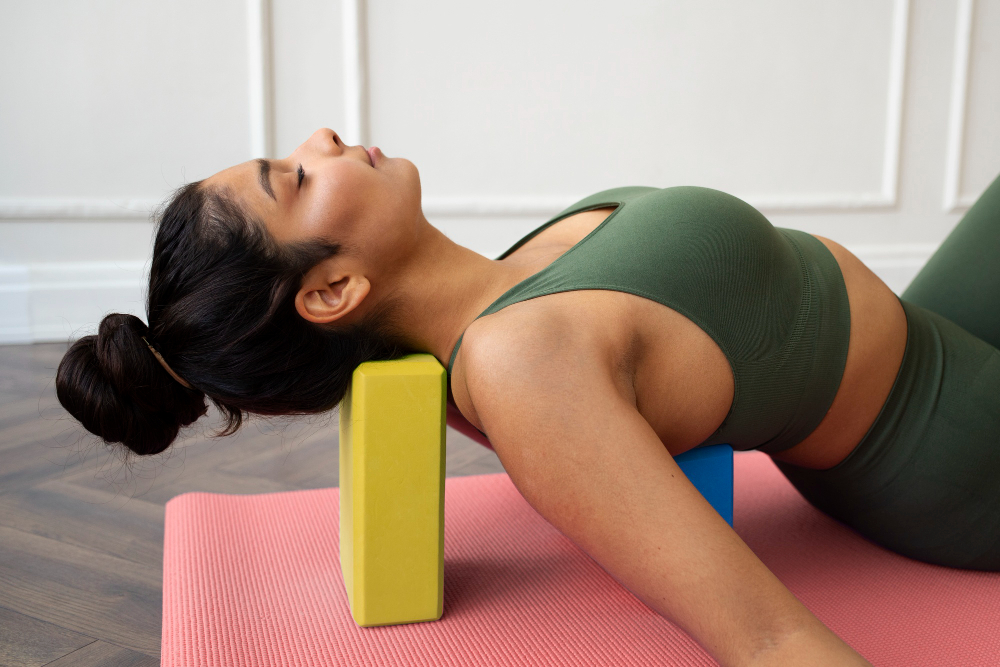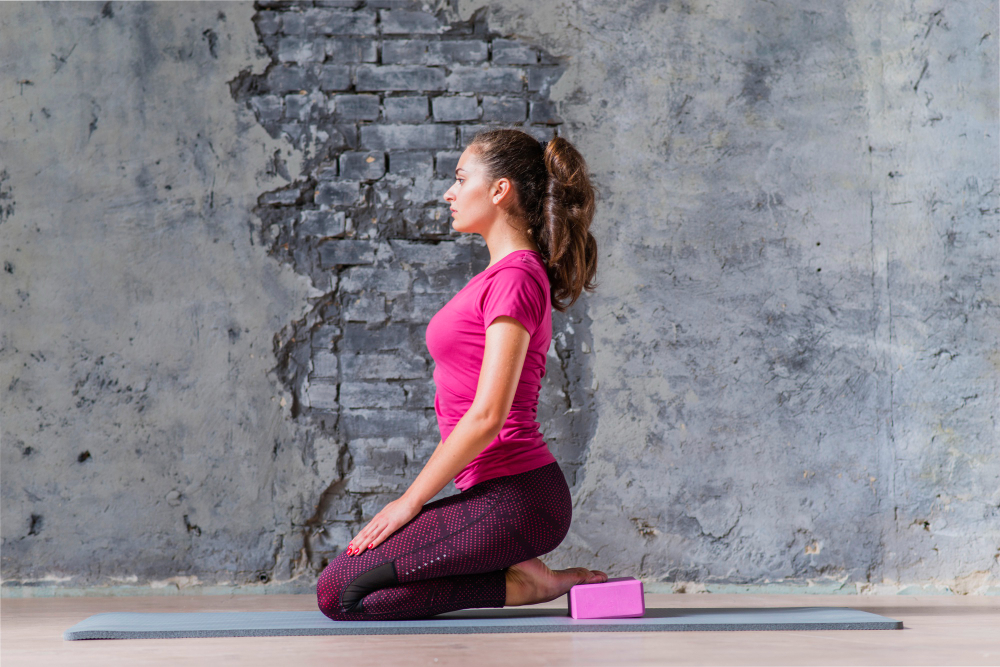Introduction
Yoga blocks are one of the most versatile and essential props in the world of yoga. Whether you are a beginner or an experienced yogi, these simple yet effective tools can significantly enhance your practice. This guide will explore what yoga blocks are, their benefits, and how to use them effectively to improve your flexibility, strength, and alignment.
What Are Yoga Blocks?
Yoga blocks are rectangular blocks made from various materials, including foam, cork, and wood. They are designed to provide support, stability, and balance during yoga practice. Typically, yoga blocks measure about 9 x 6 x 4 inches, but they come in various sizes to accommodate different needs and preferences.

Types of Yoga Blocks:
Foam Blocks
Description:
Foam blocks are typically made from high-density EVA (Ethylene Vinyl Acetate) foam. They are lightweight, soft, and come in a variety of colors.
Benefits:
- Lightweight: Easy to carry, making them perfect for home practice or taking to the studio.
- Softness: Provides a cushioned support, which is gentle on the body. Ideal for sensitive areas like the lower back, neck, or knees.
- Affordable: Generally more cost-effective compared to cork or wooden blocks, making them accessible for beginners.
- Versatile: Suitable for a wide range of poses and yoga styles, from restorative to dynamic practices.
Ideal For:
- Beginners: Provides extra support and cushioning, making it easier to perform poses with proper alignment.
- Travel: Due to their lightweight nature, they are convenient to pack and carry.
Considerations:
- Durability: Foam blocks may compress over time with heavy use.
- Stability: While adequate for most practices, they may not provide as much stability as cork or wooden blocks for certain advanced poses.
Cork Blocks
Description:
Cork blocks are made from natural cork, derived from the bark of cork oak trees. They are heavier and more robust than foam blocks.
Benefits:
- Stability: The denser material offers excellent stability, making them ideal for standing poses and balance work.
- Eco-Friendly: Cork is a renewable resource and biodegradable, making it an environmentally conscious choice.
- Durability: More durable than foam blocks, cork blocks maintain their shape and support over time.
- Texture: Provides a non-slip surface, even when slightly wet, which can be beneficial during sweaty practices.
Ideal For:
- Intermediate to Advanced Yogis: Offers the stability needed for more challenging poses.
- Eco-Conscious Practitioners: Appeals to those who prefer sustainable and natural materials.
Considerations:
- Weight: Heavier than foam blocks, which may be less convenient to carry.
- Firmness: Although they provide excellent support, they are less forgiving on the body compared to foam blocks.
Wooden Blocks
Description:
Wooden blocks are usually made from solid wood like bamboo, birch, or pine. They are the heaviest and most durable type of yoga block.
Benefits:
- Support: Offers the most support and stability, ideal for rigorous and alignment-focused practices.
- Durability: Extremely long-lasting, wooden blocks can withstand heavy use without losing shape or integrity.
- Aesthetic: Often preferred for their natural and elegant appearance.
Ideal For:
- Advanced Practitioners: Provides the stability and support needed for advanced poses and transitions.
- Professional Studios: Durable enough for high-frequency use in yoga studios.
Considerations:
- Weight: The heaviest option, which can be a drawback for portability.
- Comfort: The rigid surface may be uncomfortable for some poses, especially those requiring cushioning.
Choosing the Right Block for Your Practice
When selecting a yoga block, consider your personal needs and practice style:
- Comfort vs. Stability: Foam blocks offer more comfort and are gentler on the body, while cork and wooden blocks provide greater stability and support.
- Portability: If you travel frequently or carry your blocks to and from the studio, foam blocks might be the most convenient option due to their lightweight nature.
- Durability: For a long-lasting option, cork and wooden blocks are more durable and maintain their shape and support over time.
- Eco-Friendliness: Cork blocks are the most environmentally friendly choice, being made from renewable and biodegradable materials.
Benefits of Using Yoga Blocks
Enhanced Flexibility:
Yoga blocks can help you achieve deeper stretches and poses that might be challenging due to limited flexibility. By bringing the floor closer to you, blocks allow you to ease into postures gradually.
Improved Alignment:
Using blocks ensures proper alignment in poses, which is crucial for preventing injuries and getting the most out of your practice. They help you maintain correct posture, especially in standing and balancing poses.
Increased Strength:
Blocks can be used to add resistance and intensity to your practice. Incorporating them into strength-building exercises helps to engage and strengthen muscles more effectively.
Support and Stability:
For beginners and those with physical limitations, yoga blocks provide much-needed support. They can help you maintain balance and stability in challenging poses, making your practice safer and more accessible.
How to Use Yoga Blocks
In Standing Poses:
- Triangle Pose (Trikonasana):
- Place a block on the floor outside your front foot.
- Rest your bottom hand on the block to support your torso and maintain proper alignment.
- Half Moon Pose (Ardha Chandrasana):
- Use a block under your bottom hand to elevate the floor and help you balance.
- Adjust the block’s height to match your flexibility level.
In Sitting Poses:
- Seated Forward Fold (Paschimottanasana):
- Place a block under your sit bones to elevate your hips and create more space for your spine to lengthen.
- Hero Pose (Virasana):
- Sit on a block between your heels to reduce strain on your knees and ankles, making the pose more comfortable.
In Reclining Poses:
- Supported Bridge Pose (Setu Bandhasana):
- Place a block under your sacrum for support and hold the pose longer with less effort.
- Reclining Bound Angle Pose (Supta Baddha Konasana):
- Use blocks under your knees to support your legs and open your hips gently.
In Balancing Poses:
- Crow Pose (Bakasana):
- Place a block under your feet to elevate your body and make it easier to lift into the pose.
- L-Shape Handstand:
- Use blocks under your hands to create stability and provide extra height as you kick up into the handstand.
In Restorative Poses:
- Supported Fish Pose (Matsyasana):
- Place a block under your upper back and another under your head to open your chest and shoulders.
- Legs-Up-the-Wall Pose (Viparita Karani):
- Use a block under your hips to elevate your pelvis and deepen the relaxation.
Tips for Using Yoga Blocks
- Start Slow: Begin with basic poses and gradually incorporate blocks into more challenging postures as you become comfortable.
- Experiment with Heights: Yoga blocks have three different height settings, allowing you to customize the support you need.
- Listen to Your Body: Use blocks to make poses accessible and comfortable, not to force yourself into positions that cause discomfort or pain.
- Seek Guidance: If you’re new to yoga blocks, consider taking a class or watching instructional videos to learn proper techniques and modifications.
Conclusion
Yoga blocks are invaluable tools that can transform your practice, offering support, enhancing flexibility, and ensuring proper alignment. By understanding what yoga blocks are and how to use them, you can make your yoga journey more enjoyable and effective. Whether you’re a beginner or a seasoned practitioner, incorporating yoga blocks into your routine can help you achieve a deeper, safer, and more fulfilling practice.
FAQ
What are yoga blocks?
Yoga blocks are rectangular props made from materials such as foam, cork, and wood. They are designed to provide support, stability, and balance during yoga practice.
What sizes do yoga blocks come in?
Typically, yoga blocks measure about 9 x 6 x 4 inches, but they are available in various sizes to accommodate different needs and preferences.
What are the benefits of using foam blocks?
Lightweight: Easy to carry, making them perfect for home practice or taking to the studio.
Softness: Provides cushioned support, which is gentle on the body. Ideal for sensitive areas like the lower back, neck, or knees.
Affordable: Generally more cost-effective compared to cork or wooden blocks, making them accessible for beginners.
Versatile: Suitable for a wide range of poses and yoga styles, from restorative to dynamic practices.
What are the benefits of cork blocks?
Stability: The denser material offers excellent stability, making them ideal for standing poses and balance work.
Eco-Friendly: Cork is a renewable resource and biodegradable, making it an environmentally conscious choice.
Durability: More durable than foam blocks, cork blocks maintain their shape and support over time.
Texture: Provides a non-slip surface, even when slightly wet, which can be beneficial during sweaty practices.
What are the benefits of wooden blocks?
Support: Offers the most support and stability, ideal for rigorous and alignment-focused practices.
Durability: Extremely long-lasting, wooden blocks can withstand heavy use without losing shape or integrity.
Aesthetic: Often preferred for their natural and elegant appearance.
How do I choose the right yoga block for my practice?
Comfort vs. Stability: Foam blocks offer more comfort and are gentler on the body, while cork and wooden blocks provide greater stability and support.
Portability: If you travel frequently or carry your blocks to and from the studio, foam blocks might be the most convenient option due to their lightweight nature.
Durability: For a long-lasting option, cork and wooden blocks are more durable and maintain their shape and support over time.
Eco-Friendliness: Cork blocks are the most environmentally friendly choice, being made from renewable and biodegradable materials.
How do yoga blocks improve alignment?
Using blocks ensures proper alignment in poses, which is crucial for preventing injuries and getting the most out of your practice. They help you maintain correct posture, especially in standing and balancing poses.


2 thoughts on “Yoga Blocks 101: What They Are and How to Use Them”